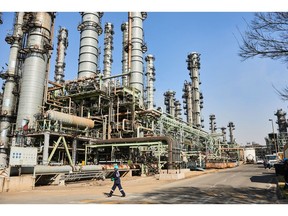
Article content
(Bloomberg) — Sasol Ltd. plans to run its flagship plant at full capacity, offsetting the use of coal feedstock by sourcing more renewables as part of a strategy by the world’s top producer of synthetic fuel from coal to improve its business.
THIS CONTENT IS RESERVED FOR SUBSCRIBERS ONLY
Subscribe now to read the latest news in your city and across Canada.
- Exclusive articles from Barbara Shecter, Joe O'Connor, Gabriel Friedman, and others.
- Daily content from Financial Times, the world's leading global business publication.
- Unlimited online access to read articles from Financial Post, National Post and 15 news sites across Canada with one account.
- National Post ePaper, an electronic replica of the print edition to view on any device, share and comment on.
- Daily puzzles, including the New York Times Crossword.
SUBSCRIBE TO UNLOCK MORE ARTICLES
Subscribe now to read the latest news in your city and across Canada.
- Exclusive articles from Barbara Shecter, Joe O'Connor, Gabriel Friedman and others.
- Daily content from Financial Times, the world's leading global business publication.
- Unlimited online access to read articles from Financial Post, National Post and 15 news sites across Canada with one account.
- National Post ePaper, an electronic replica of the print edition to view on any device, share and comment on.
- Daily puzzles, including the New York Times Crossword.
REGISTER / SIGN IN TO UNLOCK MORE ARTICLES
Create an account or sign in to continue with your reading experience.
- Access articles from across Canada with one account.
- Share your thoughts and join the conversation in the comments.
- Enjoy additional articles per month.
- Get email updates from your favourite authors.
THIS ARTICLE IS FREE TO READ REGISTER TO UNLOCK.
Create an account or sign in to continue with your reading experience.
- Access articles from across Canada with one account
- Share your thoughts and join the conversation in the comments
- Enjoy additional articles per month
- Get email updates from your favourite authors
Sign In or Create an Account
or
Article content
Article content
South Africa’s second-biggest emitter of greenhouse gases will aim to ramp up the Secunda synthetic-fuels facility as close to a nameplate capacity of 7.6 million tons a year as possible, while maintaining its target of reducing emissions by 30% by 2030.
Article content
Article content
“We have to decarbonize — we will — but we’ll never decarbonize by shutting down,” Sasol Chief Executive Officer Simon Baloyi said in an interview on the company’s Capital Markets Day strategy. Instead, it will expand a renewable-energy target by about two thirds to 2,000 megawatts.
Article content
By signing up you consent to receive the above newsletter from Postmedia Network Inc.
Article content
“We need to work on offsets so that we can keep the fossil fuel part running as long as possible,” he said.
Article content
Sasol’s first so-called CMD plan in four years comes during a turbulent oil market — that correlates with its fuel business — and US President Donald Trump’s irregular tariff oscillations that affect supply chains. The stock has slumped for the past year, with investors eager for details on a future strategy.
Article content
As the company focuses on improving coal quality to ramp up Secunda and cutting costs, it’s working on improving the chemical arm to earn as much as $1 billion annually, more than three times its current contribution, to the group in the next five years, said Baloyi.
Article content
“We spent $12 billion on our international chemical business and we have to make sure we turn around that business,” he told reporters. Sasol spent $12.8 billion on the Lake Charles chemicals facility in Louisiana.
Article content
Article content
Sasol has put in place protections from ongoing volatility in crude and foreign-exchange markets. For this year, it’s completed an oil-hedging program that set the floor at around $60 a barrel, which is around the break-even price, and it has covered most volumes for the next, according to Sasol Chief Financial Officer Walt Bruns.
Article content
The company is also lowering the net-debt level needed to trigger a dividend to $3 billion in fiscal 2027 from $4 billion, he said. It exceeded this in 2024, resulting in it skipping a final payout.
Article content
Sasol initially estimated that its emissions-reduction roadmap to reach the 30% cut would cost as much as 25 billion rand ($1.4 billion). It’s trimmed that to 7 billion because it’s opted not to supply Secunda with liquefied natural gas to displace coal.
Article content
Baloyi said some of the preliminary agreements that Sasol has announced over the last year or so — including a sustainable aviation business with Topsoe, a partnership with South African state-owned power utility Eskom Holdings SOC Ltd. on gas aggregation, and a clean-energy platform with Discovery Green — are signs of a longer-term move to a lower carbon-energy business.
Article content
“You won’t see us bringing gas to use our own facility, but gas-to-power we’ll probably do; we will do renewables” along with sustainable aviation fuel, the CEO said. “Naturally, we will slowly start to move away from fossil fuel.”
Article content
Sign up here for the twice-weekly Next Africa newsletter, and subscribe to the Next Africa podcast on Apple, Spotify or anywhere you listen.
Article content

.jpg) 7 hours ago
1
7 hours ago
1
 English (US)
English (US)